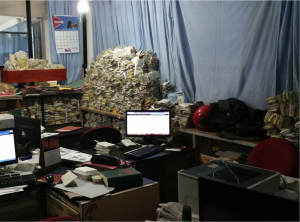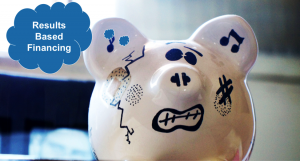MERL on the Money: Are we getting funding for data right?
By Paige Kirby, Senior Policy Advisor at Development Gateway
Time for a MERL pop quiz: Out of US $142.6 billion spent in ODA each year, how much goes to M&E?
A) $14.1-17.3 billion
B) $8.6-10 billion
C) $2.9-4.3 billion
It turns out, the correct answer is C. An average of only $2.9-$4.3 billion — or just 2-3% of all ODA spending — goes towards M&E.
That’s all we get. And despite the growing breadth of logframes and depths of donor reporting requirements, our MERL budgets are likely not going to suddenly scale up.
So, how can we use our drop in the bucket better, to get more results for the same amount of money?
At Development Gateway, we’ve been doing some thinking and applied research on this topic, and have three key recommendations for making the most of MERL funding.
Teamwork

When seeking information for a project baseline, midline, endline, or anything in between, it has become second nature to budget for collecting (or commissioning) primary data ourselves.
Really, it would be more cost-and time-effective for all involved if we got better at asking peers in the space for already-existing reports or datasets. This is also an area where our donors – particularly those with large country portfolios – could help with introductions and matchmaking.
Consider the Public Option

And speaking of donors as a second point – why are we implementers responsible for collecting MERL relevant data in the first place?
If partner governments and donors invested in country statistical and administrative data systems, we implementers would not have such incentive or need to conduct one-off data collection.
For example, one DFID Country Office we worked with noted that a lack of solid population and demographic data limited their ability to monitor all DFID country programming. As a result, DFID decided to co-fund the country’s first census in 30 years – which benefited DFID and non-DFID programs.
The term “country systems” can sound a bit esoteric, pretty OECD-like – but it really can be a cost-effective public good, if properly resourced by governments (or donor agencies), and made available.
Flip the Paradigm

And finally, a third way to get more bang for our buck is – ready or not – Results Based Financing, or RBF. RBF is coming (and, for folks in health, it’s probably arrived). In an RBF program, payment is made only when pre-determined results have been achieved and verified.
But another way to think about RBF is as an extreme paradigm shift of putting M&E first in program design. RBF may be the shake-up we need, in order to move from monitoring what already happened, to monitoring events in real-time. And in some cases – based on evidence from World Bank and other programming – RBF can also incentivize data sharing and investment in country systems.
Ultimately, the goal of MERL should be using data to improve decisions today. Through better sharing, systems thinking, and (maybe) a paradigm shake-up, we stand to gain a lot more mileage with our 3%.
You might also like
-
What’s happening with GenAI Ethics and Governance?
-
Join the AI and African Evaluation Working Group Meet ‘n’ Mix Session on May 7!
-
Hands on with GenAI: predictions and observations from The MERL Tech Initiative and Oxford Policy Management’s ICT4D Training Day
-
When Might We Use AI for Evaluation Purposes? A discussion with New Directions for Evaluation (NDE) authors